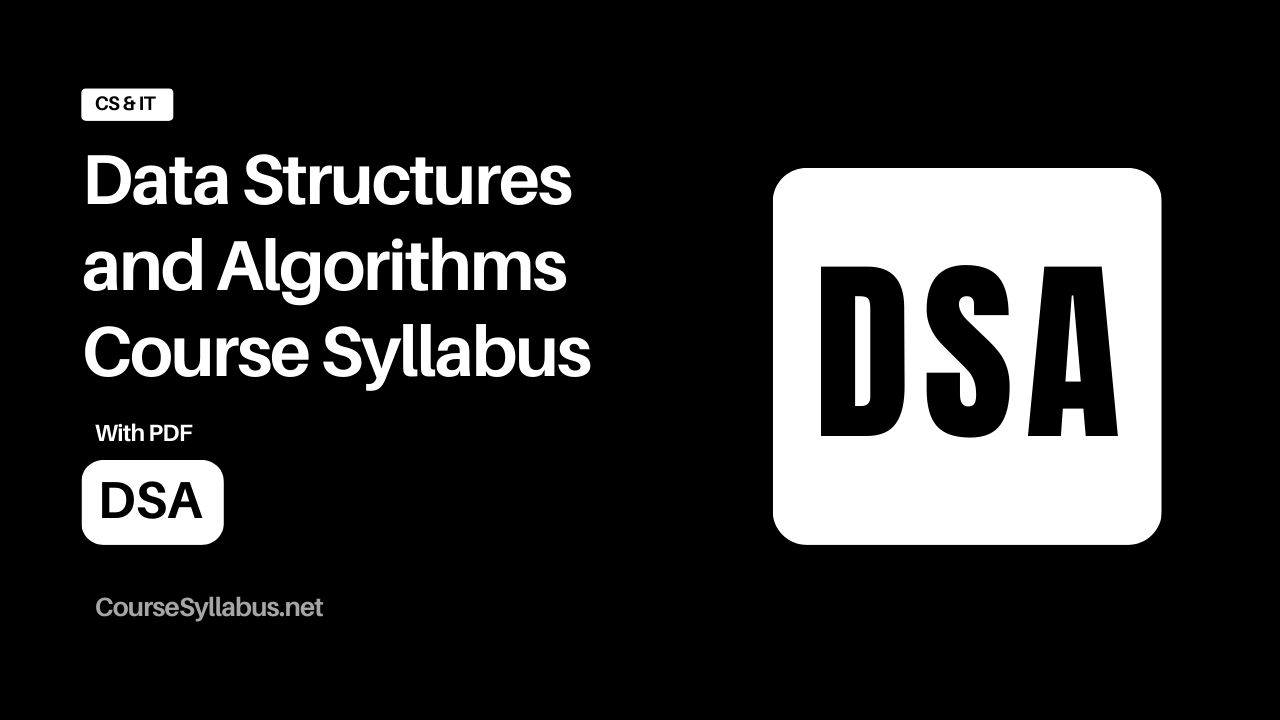Data Structures and Algorithms (DSA) are fundamental concepts in computer science. Data structures are methods of organizing and storing data effectively, like arrays or trees. Algorithms are step-by-step procedures for solving problems efficiently. Together, they form the basis of problem-solving in programming and software development, enabling efficient data manipulation and retrieval.
Data Structures and Algorithms (DSA) Course Syllabus
Module 1: Introduction to Data Structures and Algorithms
- Overview of data structures and algorithms
- Importance and applications in computer science
- Basic concepts: abstraction, complexity analysis, time and space complexity
Module 2: Basic Data Structures
2.1 Arrays and Strings
- Introduction to arrays
- Operations on arrays: traversal, insertion, deletion
- Strings: basic operations and string manipulation
2.2 Linked Lists
- Singly linked lists
- Doubly linked lists
- Circular linked lists
- Operations on linked lists: insertion, deletion, traversal
2.3 Stacks and Queues
- Introduction to stacks and queues
- Implementing stacks and queues using arrays and linked lists
- Operations on stacks and queues: push, pop, enqueue, dequeue
Module 3: Advanced Data Structures
3.1 Trees
- Introduction to trees
- Binary trees: properties, types
- Binary search trees (BST)
- Tree traversal algorithms: inorder, preorder, postorder
- AVL trees, Red-Black trees
3.2 Heaps and Priority Queues
- Introduction to heaps
- Max and min heaps
- Priority queues and operations
3.3 Hash Tables
- Introduction to hash tables
- Hashing techniques: chaining, open addressing
- Collision resolution methods
3.4 Graphs
- Introduction to graphs
- Representations of graphs: adjacency matrix, adjacency list
- Graph traversal algorithms: BFS, DFS
- Shortest path algorithms: Dijkstra’s algorithm, Bellman-Ford algorithm
Module 4: Algorithm Design Techniques
4.1 Greedy Algorithms
- Introduction to greedy algorithms
- Greedy algorithm design techniques
- Applications of greedy algorithms
4.2 Divide and Conquer
- Introduction to divide and conquer
- Algorithm design techniques
- Applications of divide and conquer
4.3 Dynamic Programming
- Introduction to dynamic programming
- Memoization and tabulation techniques
- Applications of dynamic programming
Module 5: Advanced Algorithms
5.1 Searching and Sorting Algorithms
- Linear search, binary search
- Bubble sort, insertion sort, selection sort
- Merge sort, quicksort, heap sort
5.2 Advanced Topics
- String matching algorithms
- NP-hard and NP-complete problems
- Approximation algorithms
Module 6: Advanced Data Structures and Algorithm Analysis
6.1 Advanced Data Structures
- Disjoint-set data structure
- Trie
- Segment tree
- Fenwick tree
6.2 Algorithm Analysis
- Asymptotic analysis: Big O, Big Theta, Big Omega
- Amortized analysis
- Space complexity analysis
Module 7: Problem-solving and Practice
- Solving problems from various online platforms (LeetCode, HackerRank, Codeforces, etc.)
- Algorithmic problem-solving techniques
- Practice sessions and coding challenges
DSA Learning Resources
There are many resources available for learning DSA ranging from online tutorials and courses to books and interactive platforms. Here are some popular options:
Time for Learning DSA
Beginner Level:
- Time: 1-3 months
- Focus: Basic data structures (arrays, linked lists, stacks, queues), introductory algorithms (searching, sorting), understanding time complexity.
Intermediate Level:
- Time: 3-6 months
- Focus: Advanced data structures (trees, graphs, hash tables), deeper understanding of algorithms (divide and conquer, dynamic programming), analyzing algorithms for efficiency.
Advanced Level:
- Time: 6+ months
- Focus: Mastering complex data structures (trie, segment tree, Fenwick tree), advanced algorithm design techniques (greedy algorithms, NP-hard problems), solving challenging problems and participating in coding competitions.
Why DSA is Important?
Problem Solving: DSA equips you with effective problem-solving techniques, enabling you to tackle complex computational challenges efficiently.
Optimization: DSA teaches you how to optimize code for better performance, considering factors like time and space complexity, crucial for developing high-performance software.
Foundation: DSA serves as the foundational knowledge in computer science, providing the building blocks for understanding and mastering advanced concepts and technologies.
Interviews: DSA proficiency is essential for technical job interviews, where coding challenges often require solid knowledge of algorithms and data structures.
Software Development: DSA skills are indispensable for designing and building robust, scalable software systems that can handle real-world data and computational tasks effectively.
Competitive Programming: Mastery of DSA enhances performance in coding competitions, allowing you to solve algorithmic problems swiftly and efficiently, giving you a competitive edge.
Code Understanding: Understanding DSA concepts helps you comprehend and leverage existing libraries, frameworks, and APIs more effectively, enhancing your productivity as a developer.
Conclusion:
Mastering Data Structures and Algorithms (DSA) is essential for excelling in computer science and software engineering. It enables efficient problem-solving, and code optimization, and forms the foundation of crucial skills for technical interviews and competitive programming. Proficiency in DSA is key to building robust software systems and becoming a skilled developer.




